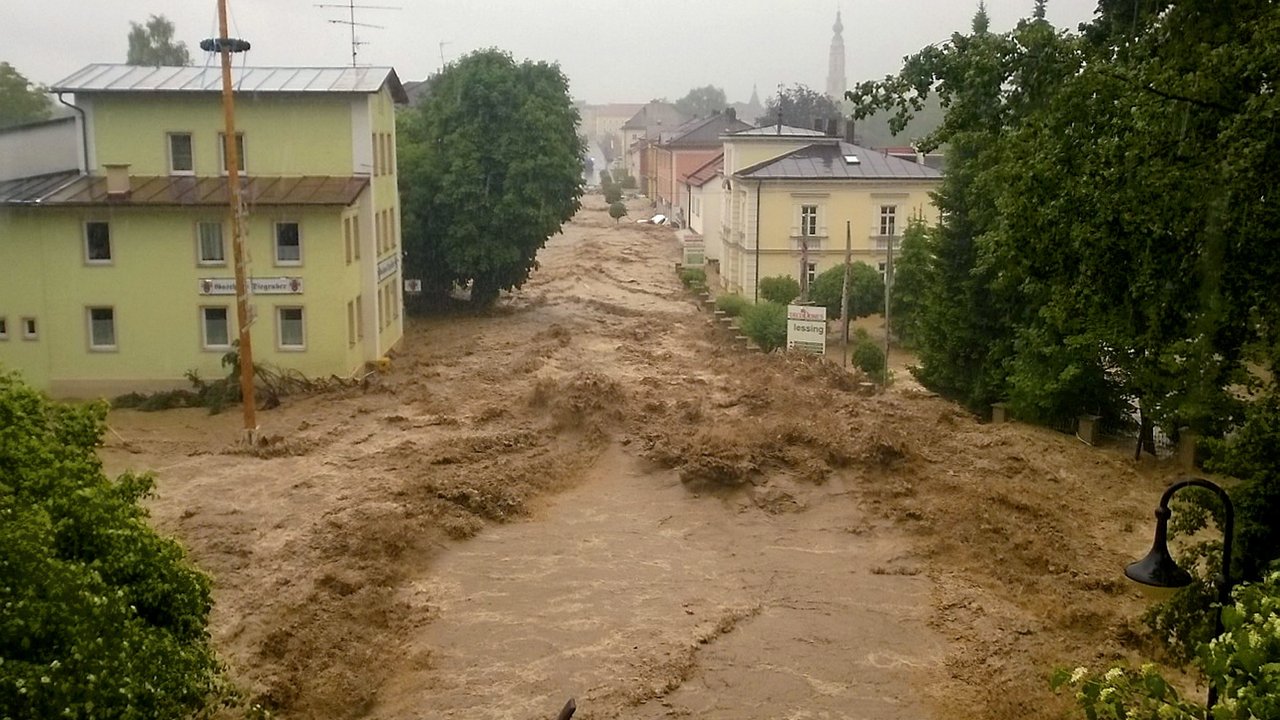
Flash floods are among the most dangerous of all natural hazards. Because structural preventive measures have only a very limited effect, flood insurance should be the method of choice to protect against loss.
A hot summer’s day: a stream runs murmuring in its bed. But then a thunderstorm moves in. All of a sudden, vast quantities of rain pour down from the skies, accompanied by thunder and lightning. The murmuring of the brook builds to a roar. In the space of a few minutes, the water level rises and the stream becomes wild and turbulent. Twigs, branches, entire trees and other debris, sometimes as big as cars, are swept along as the flash flood charges through. The water pours into cellars and underground garages and, not long after, into people’s houses. There is no time to rescue belongings. The priority here is to save your life.
People often underestimate the hazard posed by flash floods. In 2015, there were more than 120 events worldwide in which at least five people lost their lives, and over 95 in the first ten months of 2016. Many of these fatalities could have been avoided. While it may be perfectly understandable to want to rescue your car from an underground garage, it is an extremely risky undertaking during a flash flood. The water often arrives suddenly, sweeps everything before it, and develops incredible force. The potential material loss is simply not worth the danger involved. Since most vehicles are insured anyway, owners can expect to be compensated for the loss of their car.
Topography determines the flow path
Flash floods occur in conjunction with high precipitation intensity, in other words, when there is a lot of rain within a short period of time. They mainly occur as a result of thunderstorms, tropical cyclones or monsoon rains, but also with advective and orographically intensified precipitation events.
They can occur virtually anywhere and there are thousands of them each year. Many have a moderate impact, while others are life-threatening and highly destructive. Virtually all events involve losses, because the water is unable to infiltrate the soil quickly enough or find designated run-off paths, even when the soil remains absorptive. As a result, it flows over the surface in an erratic fashion, rapidly concentrating on flow paths determined by the topography. These can be watercourses and ditches, but also natural troughs and roads. The result is rapidly growing flood waves that in next to no time can reach areas which have not even had any rain.
Besides torrents of water, flash floods can affect flat terrain in the form of standing water. Since there is no gradient, the water is unable to flow away quickly enough and therefore fills any depressions in the terrain. The height of such floodwaters can range from just a few centimetres to several metres. Underpasses, underground garages and cellars are at risk, as are basements in department stores and subway tunnels. The only positive side to this type of flash flood is that the water masses are stagnant, or only flow very slowly, which means they cannot develop much erosive power or carry considerable amounts of solids.

Debris flows and mudflows
The opposite is true with debris flows and mudflows. Here the water sweeps along with it vast quantities of solid materials, which can even constitute the majority of the flow in terms of volume (up to 60%). These types of flash flood are more destructive than just water. Driftwood can become trapped in narrow locations (e.g. under bridges) and block the flow, producing backwater.
In built-up areas, obstacles to the flow and the drainage capacity of the stormwater drainage systems (sewage system) are a major factor. If the drainage capacity is exceeded, water streams out of the manholes onto the road, and from there into buildings. If there are no backwater valves, water from the sewage system can also enter homes via house drains.
Because flash floods can occur anywhere, objectively speaking, all property is at risk. People are not even safe on the top of a hill, and even less so on a hillside. Although flash floods are invariably localised events, they can also affect much larger areas. This is frequently the case with tropical storms.
Precise forecasts virtually impossible
The total amount of rainfall is often a secondary factor. What is decisive is the “suddenness” of the precipitation, and the rapid time sequence involved with flash floods. Specific warnings usually give just a few minutes’ notice. Early warnings of flash floods (several hours in advance) are based on little more than the general weather forecast. Although such forecasts have become more reliable and precise in recent years, it will remain impossible in the foreseeable future to predict exactly where and when a flash flood will occur, or how extreme it will be. Flash floods are also much shorter in duration than river floods; most of the water disappears again after a few hours.
Generally speaking, areas on the windward side of mountains are more prone to flash floods, as moist air masses are forced upwards and produce more intensive rainfall. Naturally, water will flow much more powerfully on such sloping and steep terrain.
Structural measures of little practical use
It is not easy to make provisions against extreme flash floods, and the potential for loss reduction is very limited. The main priority is clearly to save lives. Their rarity (in terms of a particular location), in conjunction with their great destructive force, virtually precludes meaningful structural precautions. Protective measures such as those along rivers cannot be adopted over a wide area, either because they are too costly, or for aesthetic, structural or technical reasons. The most important and most effective precaution is to avoid erecting a building in the immediate vicinity of potential flash flood flow paths. This includes watercourses of any size, depressions, hollows or terrain at the foot of a slope. In a new building, the ground floor, and all entrances to the building through which water can enter, should be raised a few decimetres above ground level. It is also advisable to raise the cover plates on basement shafts, to place protective walls around the outside steps leading to basements, and to incorporate flood barrier humps at the entrance to underground garages. While these offer little protection in extreme events, structures at least remain free of damage during moderate flash floods. Waterproof basement windows are a further helpful measure. Back-pressure flaps help prevent water entering from the public sewage system.
As a rule, effective protection requires permanent measures. Emergency measures (for example, clearing sections of buildings at risk) are not a viable alternative given the very short warning periods. Nevertheless, responding appropriately to flash floods can help to reduce losses, especially in extreme events where the structural measures mentioned no longer suffice.
Threat to life often underestimated
An onrushing stream can erode channels and railway embankments and undermine bridge pier and abutment foundations. Sediment and flotsam carried along by the flood pose an additional risk for people. The force of flowing water is also frequently underestimated. Studies have shown that lighter people can no longer stay on their feet in water that is ankledeep (0.2 m) and flows with a velocity of approximately 3 m/s (11 km/h). In this instance, the flow velocity v (in m/s) multiplied by the water depth D (in m) is 0.6 m2/s. Almost everyone would be knocked over when v • D becomes greater than 1.3 m2/s, a value that is reached with 3 m/s and knee-deep water (0.45 m).
Driving a car through flowing waters can also prove to be a fatal mistake. If the water is more than a few decimetres deep, it is the stream, not the driver, that determines the direction of the vehicle. Once the vehicle is partially submerged, and perhaps subject to a stronger current, it becomes extremely difficult to escape unharmed. Many lives have been lost in such situations. In the USA, more lives are lost from flash floods than from any other natural hazard: around 60 fatalities per year, with more than half of the victims dying in their vehicles.

Insurance is the solution of choice
Structural precautions and many other measures have only a limited effect in preventing losses from extreme flash floods and therefore make little economic sense in many cases. Consequently, this is an area of great interest for the insurance industry. And because structural measures are very expensive in relation to the monetary risk involved, an insurance policy offers the most efficient means of covering that risk. Since flash floods are not confined to waterways and can occur anywhere, they present little problem in terms of insurability, as there is no issue with adverse selection. The fact that there is a very low probability of any specific insured being affected by a flash flood also helps to keep the risk-commensurate premium at a modest, and therefore affordable, level.
The more people that buy insurance against flash floods in any given market, the greater the geographical balancing of risks – a favourable situation for everyone involved. For the government and society, because they save significant amounts in tax-funded financial aid following such events. For the people affected, because they have a contractually agreed financial basis to replace or rebuild what is damaged, an important aspect from a psychological perspective too. And for the insurance industry, because it improves premium income.
This is why authorities in many countries have launched extensive campaigns in cooperation with the insurance industry. These are intended to convince homeowners, businesses and companies of the real advantages of flood insurance and therefore increase insurance density. Some of the campaigns have been very successful. The Organisation for Economic Co-operation and Development (OECD) has also backed this solution and is promoting it worldwide.
Climate change exacerbating the problem
In a warmer climate, the potential water vapour content in the atmosphere will increase by 7% for each rise in temperature of 1°C. Evaporation from the world’s oceans climbs in tandem with the higher temperatures of surface water. In the future, these processes will not only generally increase the quantities of precipitation, they will also lead to more frequent extreme rainfall from local storms. In particular, the more intense convection over heavily built-up urban areas with high concentrations of values may lead to severe and extremely abrupt local weather events.
It is therefore highly probable in future that we may expect more frequent and more intensive flash floods to occur. The risks involved in loss events like these will also rise because of the growing value of assets. At the same time, we cannot assume that adaptation measures will be able to compensate for these developments. If at all, this will only happen over the very long term as a result of widespread structural adaptation of those buildings that might be affected.
In light of this, a greater awareness of the risks posed by flash floods must be created, raised and maintained at all levels: in the government, among those at risk, and in the insurance industry. While it is impossible to prevent extreme flash floods, many losses can be avoided by taking relatively simple structural and organisational measures. Insurance can take care of the rest.
Munich Re Experts

Related Topics
Newsletter
properties.trackTitle
properties.trackSubtitle
